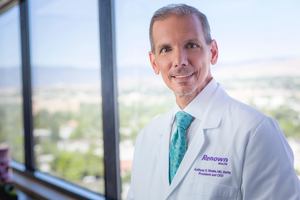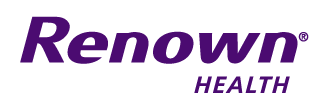The Role of Innovation and Technology in Healthcare Transformation
// By Dan Dunlop //
 As we continue to travel down the path of healthcare transformation, there are key individuals—healthcare leaders and innovators—whose ideas and actions are helping to shape the new look of healthcare delivery in America. Tony Slonim, MD, DrPH, is one such individual.
As we continue to travel down the path of healthcare transformation, there are key individuals—healthcare leaders and innovators—whose ideas and actions are helping to shape the new look of healthcare delivery in America. Tony Slonim, MD, DrPH, is one such individual.
Dr. Slonim is president and chief executive officer of Renown Health in Reno, Nevada, a not-for-profit integrated health network and Accountable Care Organization serving a 17-county region that includes northern Nevada, Lake Tahoe, and northeast California. For the past four years, he has chaired the American Journal of Managed Care’s ACO Coalition. A recognized thought leader, he also serves on the American Hospital Association’s Health Care Systems Council, representing more than 250 integrated health systems in the U.S. and their concerns.

Tony Slonim, MD, DrPH, president and chief executive officer at Renown Health
I recently had the opportunity to sit down with Dr. Slonim and discuss the future of healthcare delivery. In particular, I was curious to learn his perspective on the role of technology and innovation in healthcare transformation. Here, I’ll share excerpts from our in-depth conversation covering:
- The importance of consumer engagement as health systems shift to new models of care
- The changing role of marketing in healthcare transformation
- Innovations using predictive analytics and genetics
- How mobile technologies and virtual care are expanding access
TS: Innovation, for us, occurs in two places. First, it’s a very basic level of understanding about the way we do our work every day, and how we apply a quality improvement mindset to make things better. We bring that same philosophy to the bedside.
 We have a program grounded in lean methodology called the Transformational Healthcare Program, where we put our team members in a room for a full week, usually 12 individuals or so, to reengineer a process. We’re using the people who actually provide the care to identify new and improved ways to deliver care to people we serve. Through this process we are investing in our people and empowering them to come up with the solutions.
We have a program grounded in lean methodology called the Transformational Healthcare Program, where we put our team members in a room for a full week, usually 12 individuals or so, to reengineer a process. We’re using the people who actually provide the care to identify new and improved ways to deliver care to people we serve. Through this process we are investing in our people and empowering them to come up with the solutions.
The second place for innovation at Renown is around the things we do that are potentially world-class. For example, how does our investment in our genetics warehouse and predictive analytics better serve our needs?
The human brain is only capable of recognizing the interaction between two or three variables at a time. A supercomputer can identify relationships in the data that we never conceived of, and those relationships may be the linchpin to driving an entirely new way of delivering care.
So we’re using that supercomputer framework in our data warehouse along with predictive analytics to identify those operational improvements, genetic opportunities, and community-based interventions that may lead to new ways of delivering care that will potentially resonate with people more broadly than the traditional ways in which we’ve operated.
DD: As health systems adopt a new way of delivering care, shifting from fee-for-service to value-based models, do you see healthcare marketing undergoing a similar transformation?
TS: It is clear to me that marketing communications will shift from a focus on healthcare and service line promotion to a focus on health and wellness. In fact, it is already happening.
It is also clear that the ways in which we communicate with people in the community are changing. At Renown, we are using digital tools, social media, and blogs to engage consumers in conversations about health. So digital communication and digital platforms are playing a significant role in our marketing, and that will only grow over time.
Importantly, we’ve recognized that the people we serve all have one thing in common: They may not have a television, read a newspaper, or have a home computer, but they surely have some type of mobile device. That has to impact the way we think about care delivery and the ways in which we reach our customers with information. Ultimately, this focus on mobile technology should lead to more effective marketing and improvements in the delivery of care.
In terms of what we communicate, we need to make sure that we don’t put the cart before the horse. In the end, I’m trained as a scientist, not a marketer. I’m always concerned about overstating what we’re doing. It is important to me that we don’t get caught up in our own hype.
Health systems all over the country are now talking about health and wellness, rather than healthcare. This is a big trend. But my question is: Can they back it up? Are they walking the walk? If we start talking about health and wellness before we’ve made a transition operationally, it can lead to a disconnect in the patient experience.
DD: As a healthcare executive, have you felt the need to embrace digital communication as part of your professional role?
TS: Absolutely. Admittedly, when it comes to digital communication, I am an amateur—but I’m learning. Today, communicating with social media is quickly becoming a priority. I’ve always been involved on LinkedIn, and recently launched my own blog. I’m also enjoying being much more active on Twitter and discovering the opportunities that presents.
There are issues that are important to me, issues that are vital to the future of healthcare, and these digital channels give me a platform to share my perspectives and engage peers in conversation. On my blog, I’m using video posts to talk about accountable care, physician education, population health, physician leadership, innovations in healthcare delivery, and community partnerships. From my perspective, this is an exciting time to be a health system CEO.
DD: In what ways is Renown Health using technology to reimagine care delivery?
TS: At Renown, we cover a catchment area of 100,000 square miles. We’re the only tertiary provider between Sacramento and Salt Lake City, with some 30 rural hospitals out there where people live on the frontier. Reaching them sometimes takes a six-hour drive. Technology and mobile devices can help us deliver care both on the frontier and right here at home.
One example is the telemedicine program we’re planning and developing with the Boys & Girls Club in Reno. Moms and dads whose kids go to the Boys & Girls Club are often hourly wage earners. For them to leave work for an afternoon to take their child to see a doctor is a major expense to the family.
With our telemedicine services, we will be able to Skype mom at her place of work, the doctor at his or her office, and the child at the Boys & Girls Club. The child can receive the care he or she needs and go home with a prescription in hand, without mom or dad ever having to leave work. That’s a new way of delivering care, made possible by technology. That’s exciting.
This summer we will begin using those same telemedicine capabilities to improve the health of students in a number of elementary schools in our most impoverished ZIP codes. How can we have a children’s hospital and not partner with the local school districts? We’ve learned that improvements in community health often come down to partnerships.
We’ve got to think about how we deliver better health and well-being to children who will likely never [set] foot in our building. That interaction won’t happen in the hospital. If we want to impact their health in a positive way, we’ve got to go to them. So reaching out and partnering with others is how we’re doing it—developing new, scalable, and sustainable models of care that allow us to deliver the right care at the right time in a manner that is convenient for the people we serve.
DD: You’ve mentioned the importance of partnerships as the health system looks to establish new, more innovative models of care. Is there a particular example you could share that speaks directly to the promise of technology and innovation within healthcare delivery?
 TS: One collaboration that I’d like to highlight is Renown Health’s relationship with the Desert Research Institute (DRI). We’ve taken our clinical data over 10 years and combined it with the expertise at DRI’s environmental data platform, added in data about the social determinants of health from our community, and put it in a mega data warehouse so that we could better understand the patterns of disease and illness in our community through predictive analytics.
TS: One collaboration that I’d like to highlight is Renown Health’s relationship with the Desert Research Institute (DRI). We’ve taken our clinical data over 10 years and combined it with the expertise at DRI’s environmental data platform, added in data about the social determinants of health from our community, and put it in a mega data warehouse so that we could better understand the patterns of disease and illness in our community through predictive analytics.
The major breakthrough came when we recognized that we were missing genetic data—the missing piece of the puzzle. So we partnered with 23andMe, the direct-to-consumer genetics company, to help us with genetic testing in our community.
 We offered free genetic testing to 10,000 people in our community, sponsored by the Governor’s Office of Economic Development and the Renown Health Foundation. We had 10,000 people volunteer within 48 hours. Of importance, one-third of those 10,000 samples are from people in our five most impoverished ZIP codes. We thought that this would be a way to engage consumers in their own health, and it has more than lived up to that expectation.
We offered free genetic testing to 10,000 people in our community, sponsored by the Governor’s Office of Economic Development and the Renown Health Foundation. We had 10,000 people volunteer within 48 hours. Of importance, one-third of those 10,000 samples are from people in our five most impoverished ZIP codes. We thought that this would be a way to engage consumers in their own health, and it has more than lived up to that expectation.
DD: What do you hope to learn from the data you’ve gathered through your partnership with DRI and 23andMe?
TS: The things that we’re learning about the interactions of health, social determinants, genetic predisposition, and environment, are so important. Not only are we elaborating our understanding of our community’s health and pointing out areas where we need to make investments from a healthcare perspective, but it is helping other communities around the country learn how they might do work like this to address population and community health.
The insights we gather will help us to more effectively address population and community health. They will also help with the health system’s strategic planning as we view trends in the rise, or decline, of specific health conditions within our catchment area.
DD: Any last thoughts about the importance of innovation and technology in healthcare transformation and consumer engagement?
TS: If one of our objectives is to engage consumers effectively, then we need to think differently about how we expect them to interact with our organizations.
Think about the prevailing model, where we expect the consumer to leave work, come to the doctor’s office, wait up to two hours, have 10 or 15 minutes of time with the physician, and then leave the office with five things to follow up on. That’s not good coordination of care. And it’s not a viable model of care.
As we think about scalable and sustainable models of care, we’ve got to use technology to be more effective. It is important that we design care that is accessible and that fits within the lives of the people we serve.
Dan Dunlop is president and CEO of Jennings, an advertising and brand development agency based in Chapel Hill, North Carolina. Dunlop is an author, healthcare marketer, blogger, and frequent speaker at national and regional conferences. He is a member of the eHealthcare Strategy & Trends Editorial Advisory Board. You can find him on Twitter at @dandunlop or email him at ddunlop@jenningsco.com.

